Abstract
In Los Angeles County, the age-adjusted incidence rate of colon cancer in men is almost 30% higher than that in women; however, in the descending and sigmoid colon, age-specific incidence rates for women are higher than those for men before age 55. Since menstrual and/or reproductive factors may be involved in producing this crossover in age-specific rates, they were examined in a population-based case-control study involving 327 white women with adenocarcinoma of the colon and age-, race- and neighbourhood-matched controls. After adjustment for other factors associated with colon cancer in this study (family history of large bowel cancer, total fat intake, calcium, weight and activity level), ever having been pregnant was protective (RR = 0.56, 95% CI = 0.33-0.97). For one to two pregnancies, the RR was 0.76 (CI = 0.42-1.37); for three or more pregnancies, the RR was 0.45 (CI = 0.25-0.81). However, the relationship between the number of pregnancies and colon cancer risk was actually U-shaped, with risk decreasing with successive pregnancies up to four and then increasing with additional pregnancies. The U-shaped relationship was present for incomplete as well as for full-term pregnancies and was more striking for cancers occurring in the distal (descending and sigmoid) than proximal (caecum to splenic flexure) colon. Risk was not related to age at menarche or use of exogenous oestrogens, but delayed natural menopause was weakly protective in the proximal but not distal colon. The crossover in incidence rates in the distal colon can be completely accounted for by the pregnancy effect. The U-shape of the pregnancy curve suggests the possibility of competing factors, some protective, especially after one or several pregnancies, and others conferring increasing risk with successive pregnancies, regardless of the pregnancy outcome.
Full text
PDF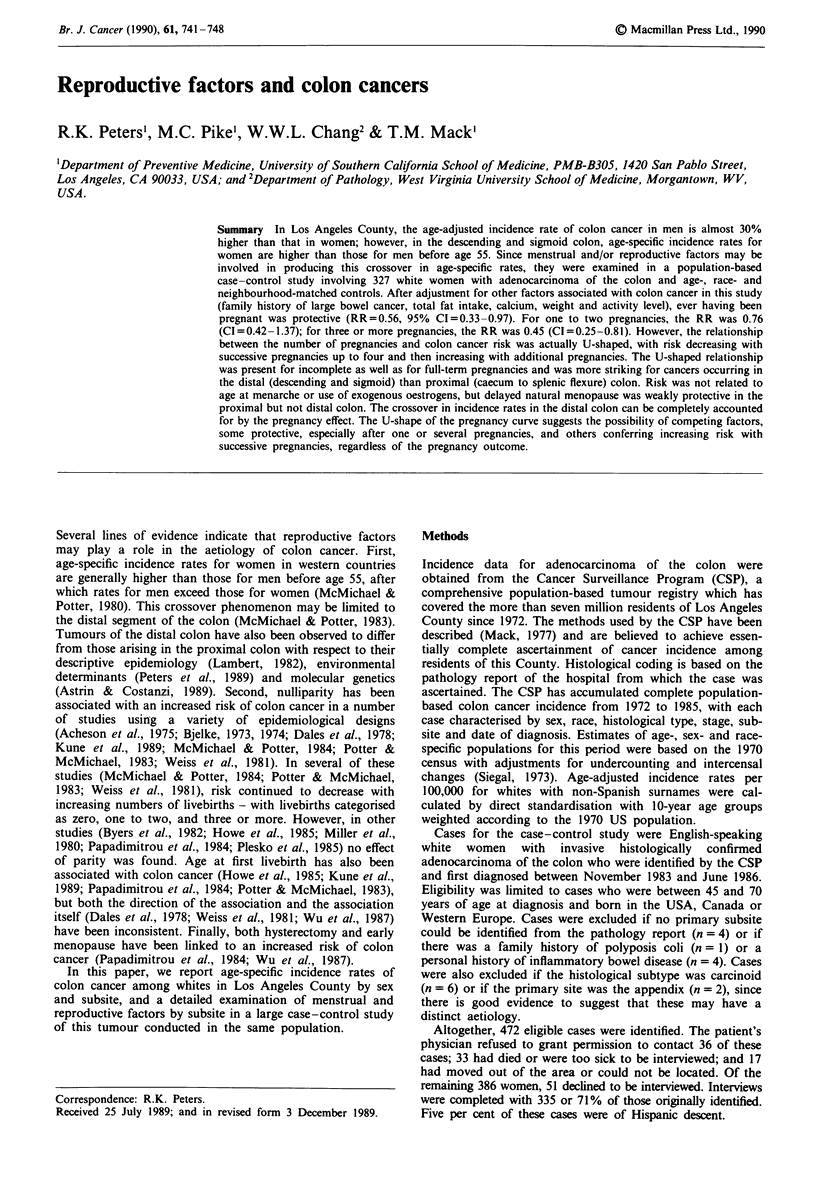
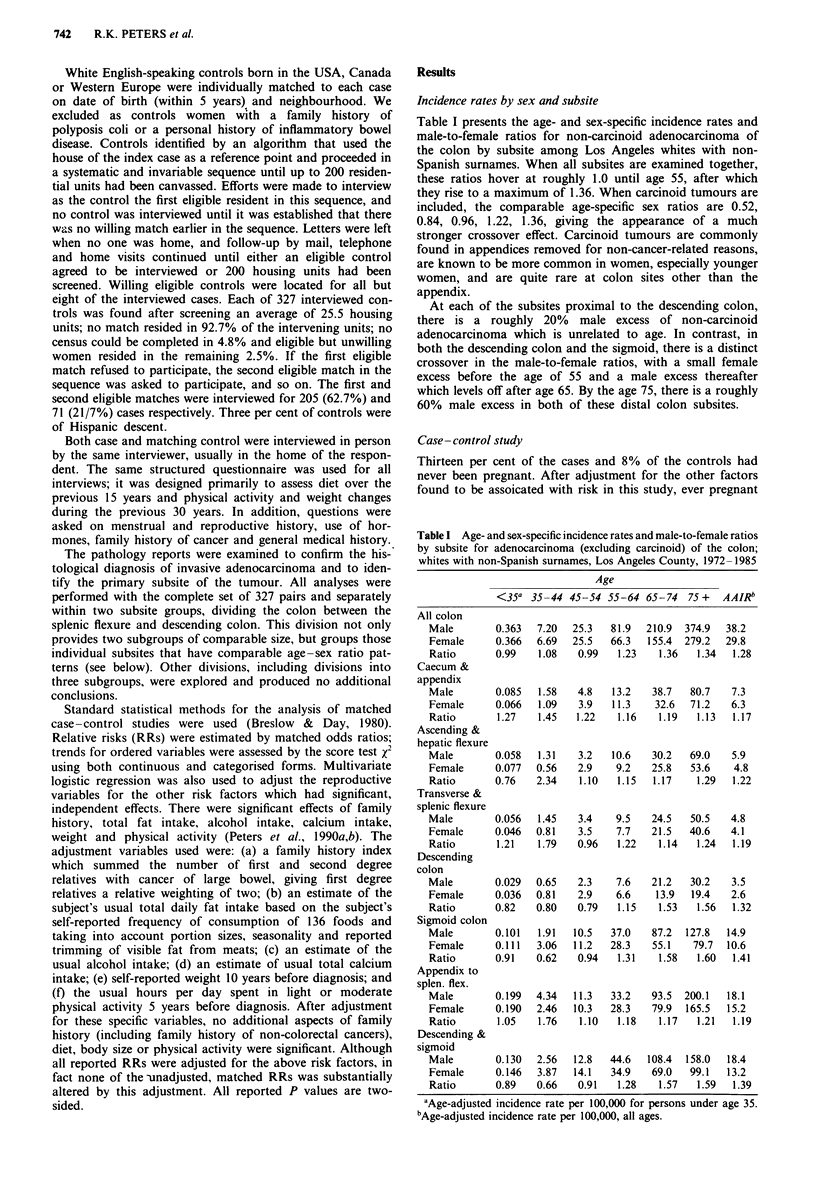
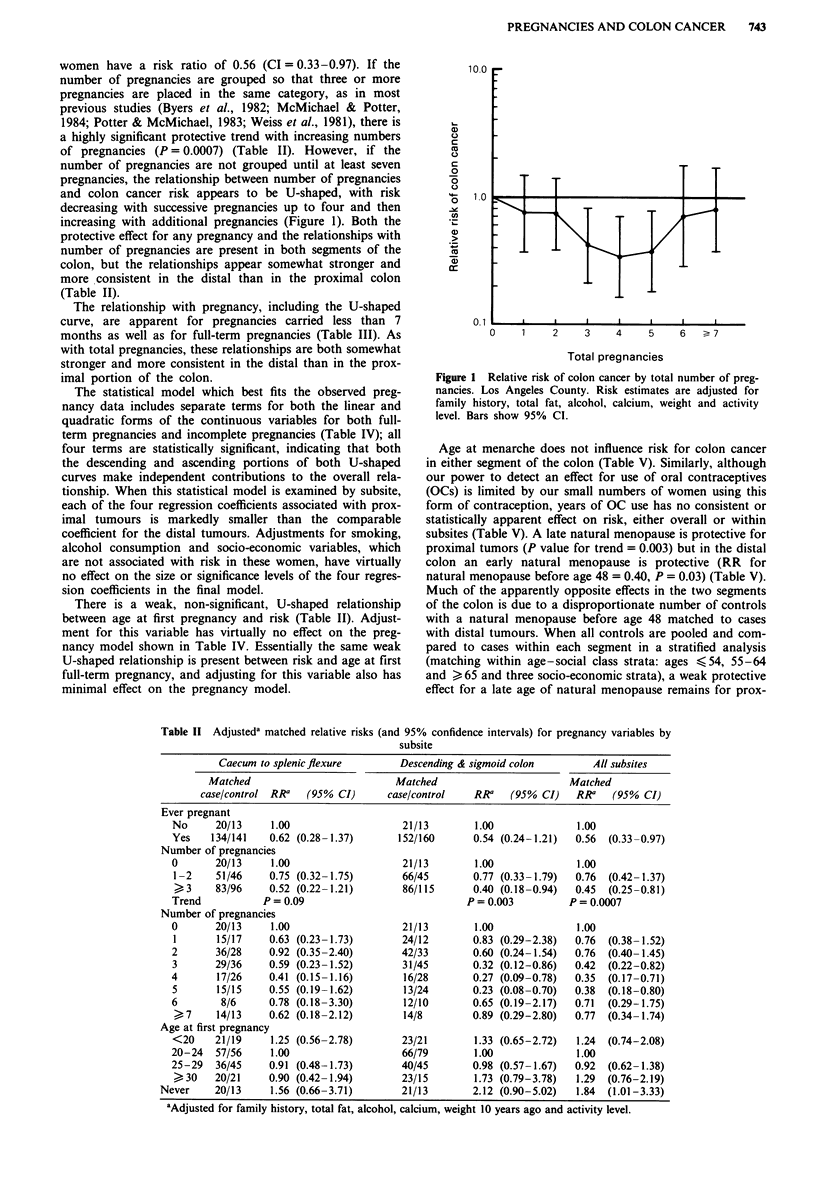
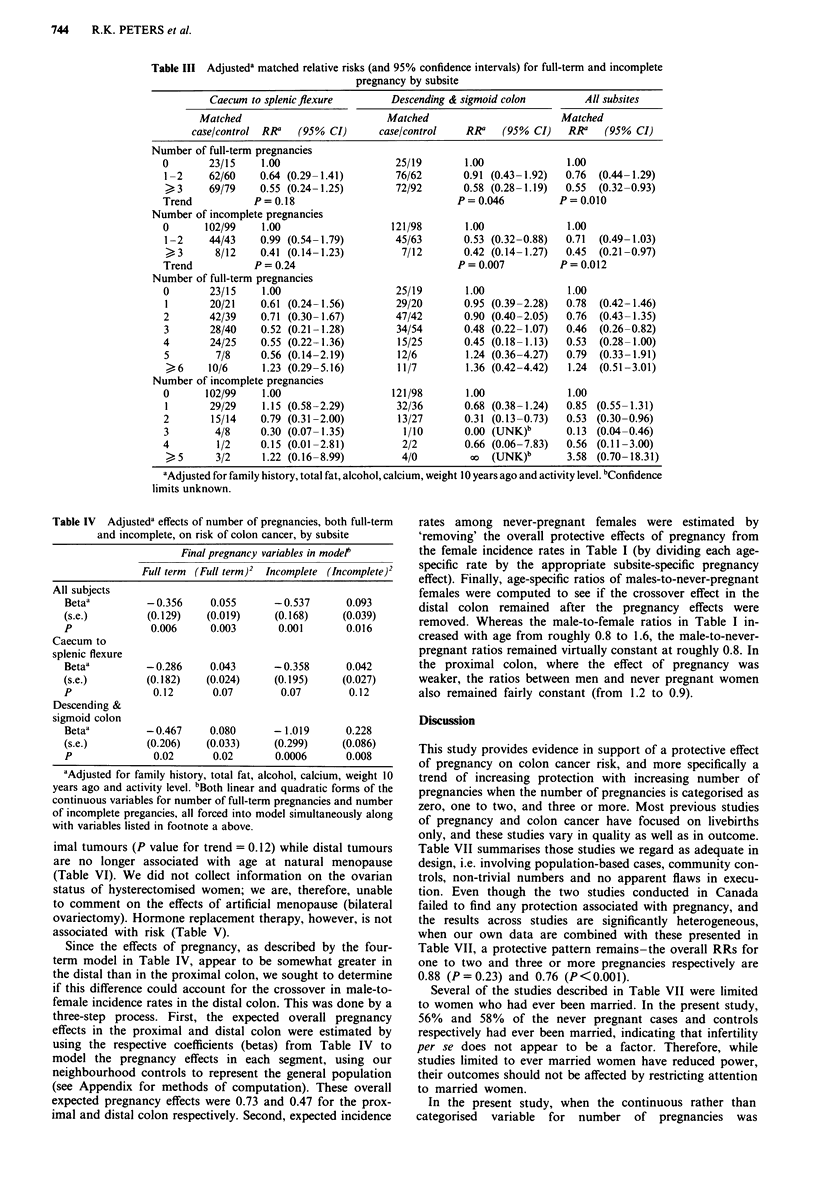
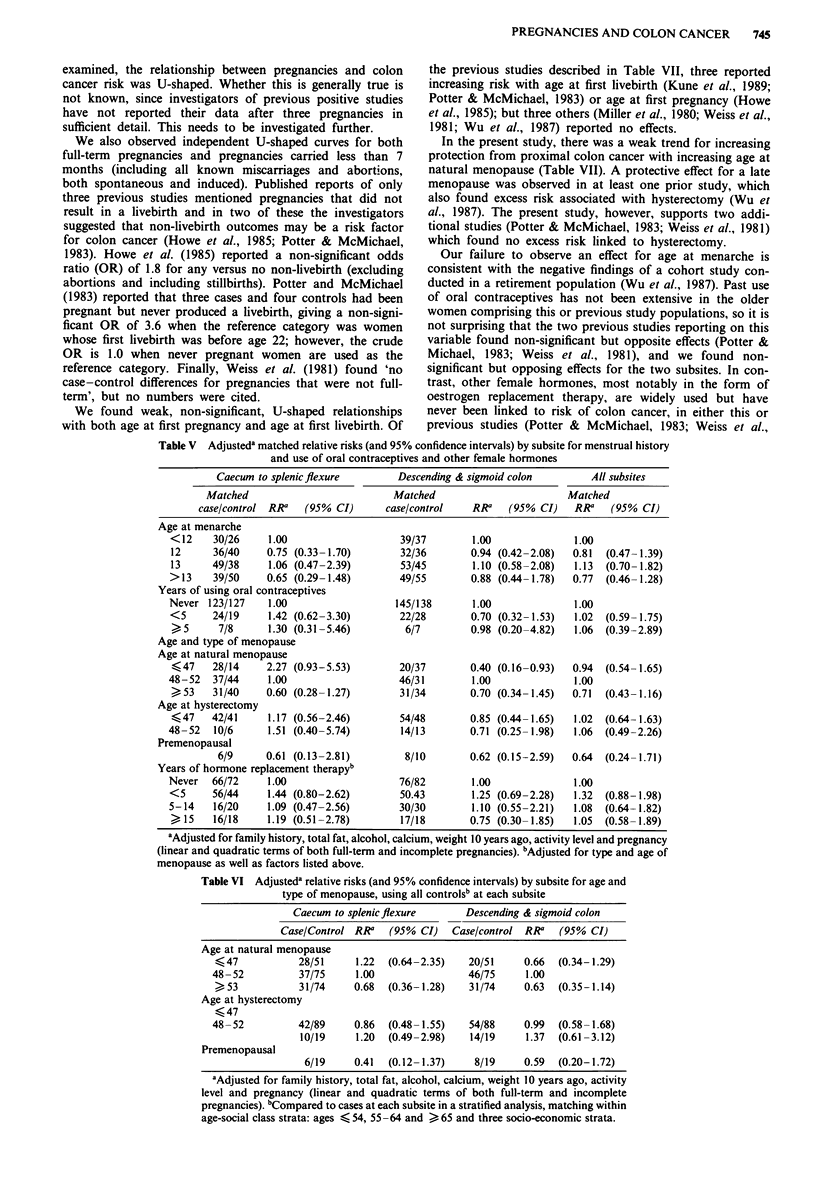
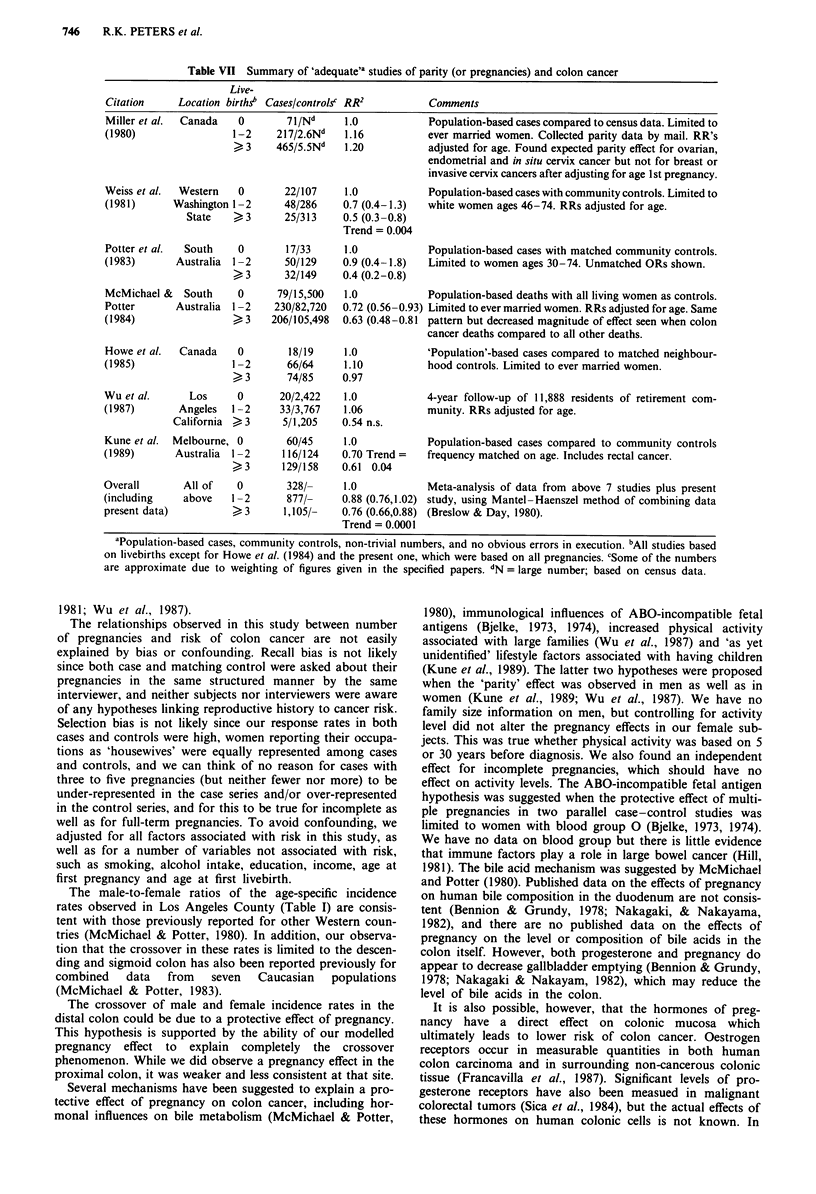
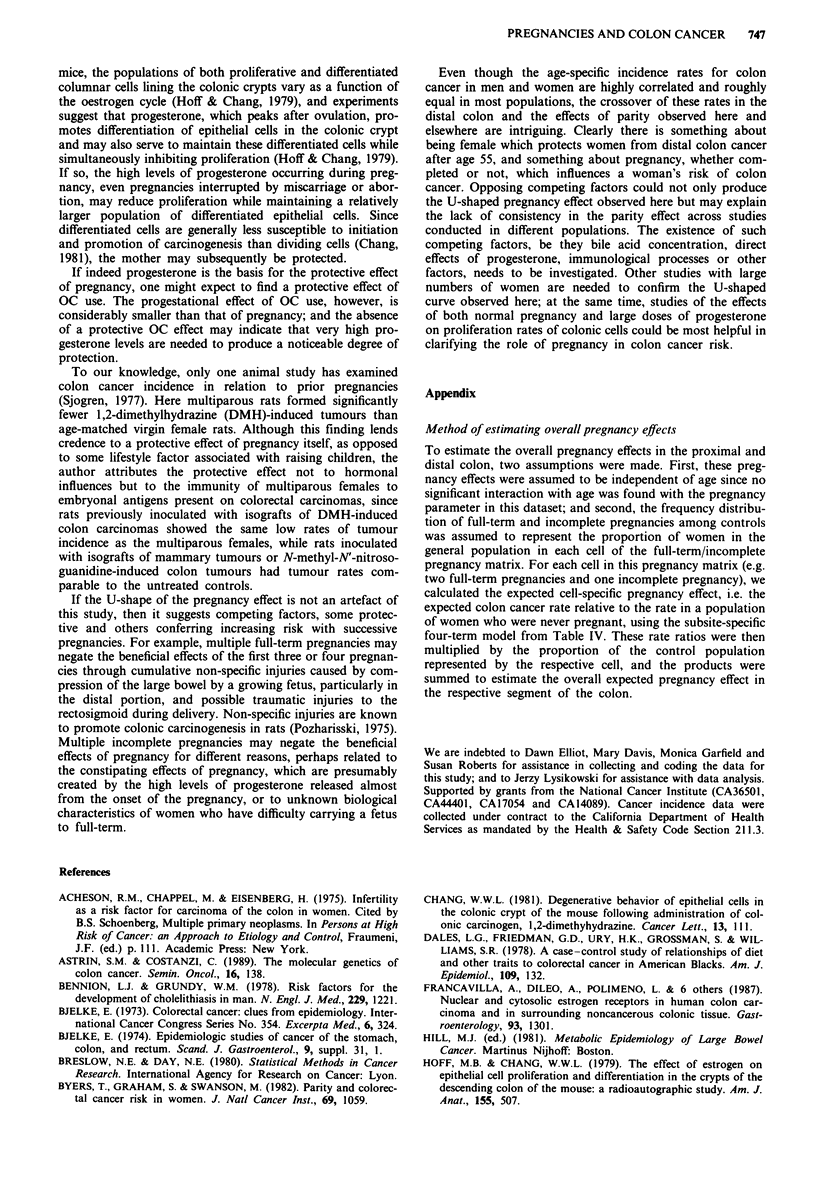
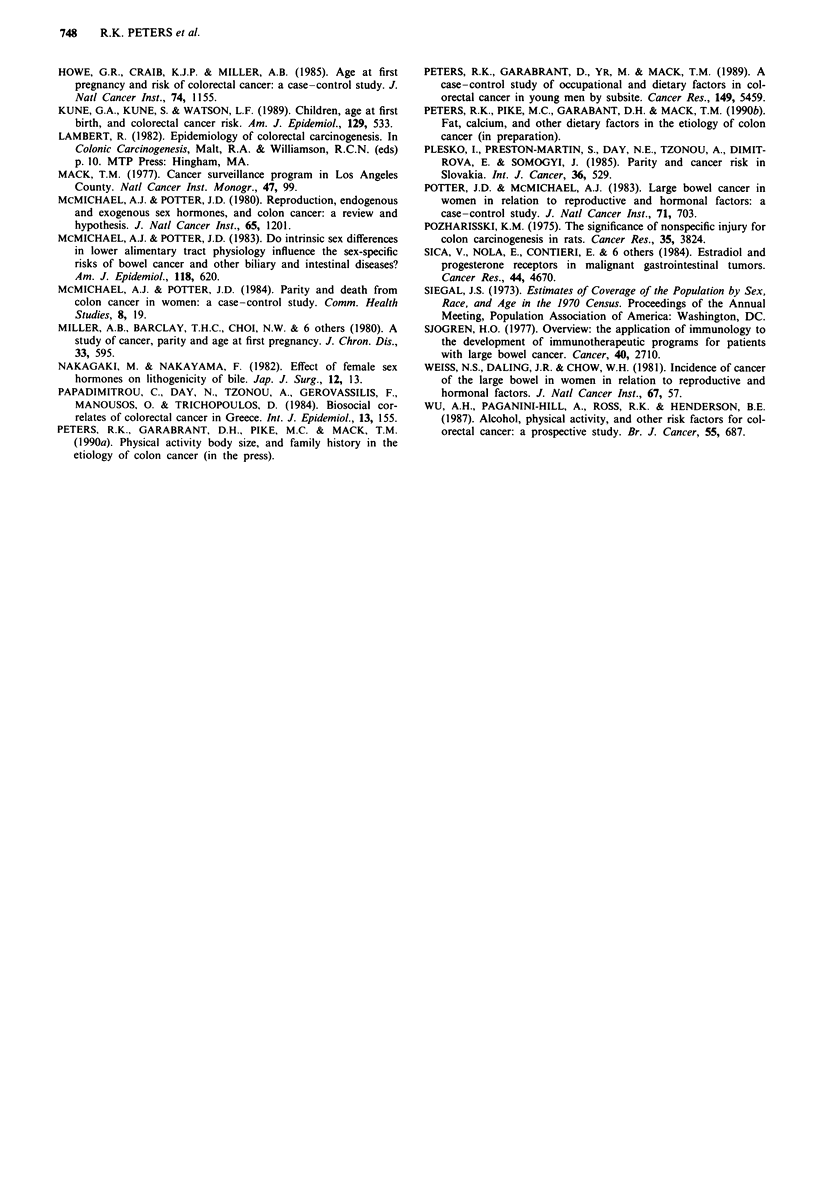
Selected References
These references are in PubMed. This may not be the complete list of references from this article.
- Astrin S. M., Costanzi C. The molecular genetics of colon cancer. Semin Oncol. 1989 Apr;16(2):138–147. [PubMed] [Google Scholar]
- Bennion L. J., Grundy S. M. Risk factors for the development of cholelithiasis in man (second of two parts). N Engl J Med. 1978 Nov 30;299(22):1221–1227. doi: 10.1056/NEJM197811302992205. [DOI] [PubMed] [Google Scholar]
- Byers T., Graham S., Swanson M. Parity and colorectal cancer risk in women. J Natl Cancer Inst. 1982 Nov;69(5):1059–1062. [PubMed] [Google Scholar]
- Chang W. W. Degenerative behavior of epithelial cells in the colonic crypt of the mouse following administration of colonic carcinogen, 1,2-dimethylhydrazine. Cancer Lett. 1981 Jul;13(2):111–118. doi: 10.1016/0304-3835(81)90136-1. [DOI] [PubMed] [Google Scholar]
- Francavilla A., Di Leo A., Polimeno L., Conte D., Barone M., Fanizza G., Chiumarulo C., Rizzo G., Rubino M. Nuclear and cytosolic estrogen receptors in human colon carcinoma and in surrounding noncancerous colonic tissue. Gastroenterology. 1987 Dec;93(6):1301–1306. doi: 10.1016/0016-5085(87)90259-9. [DOI] [PubMed] [Google Scholar]
- Hoff M. B., Chang W. W. The effect of estrogen on epithelial cell proliferation and differentiation in the crypts of the descending colon of the mouse: a radioautographic study. Am J Anat. 1979 Aug;155(4):507–516. doi: 10.1002/aja.1001550407. [DOI] [PubMed] [Google Scholar]
- Howe G. R., Craib K. J., Miller A. B. Age at first pregnancy and risk of colorectal cancer: a case-control study. J Natl Cancer Inst. 1985 Jun;74(6):1155–1159. [PubMed] [Google Scholar]
- Kune G. A., Kune S., Watson L. F. Children, age at first birth, and colorectal cancer risk. Data from the Melbourne Colorectal Cancer Study. Am J Epidemiol. 1989 Mar;129(3):533–542. doi: 10.1093/oxfordjournals.aje.a115165. [DOI] [PubMed] [Google Scholar]
- Mack T. M. Cancer surveillance program in Los Angeles County. Natl Cancer Inst Monogr. 1977 Dec;47:99–101. [PubMed] [Google Scholar]
- McMichael A. J., Potter J. D. Do intrinsic sex differences in lower alimentary tract physiology influence the sex-specific risks of bowel cancer and other biliary and intestinal diseases? Am J Epidemiol. 1983 Nov;118(5):620–627. doi: 10.1093/oxfordjournals.aje.a113672. [DOI] [PubMed] [Google Scholar]
- McMichael A. J., Potter J. D. Parity and death from colon cancer in women: a case-control study. Community Health Stud. 1984;8(1):19–25. doi: 10.1111/j.1753-6405.1984.tb00420.x. [DOI] [PubMed] [Google Scholar]
- McMichael A. J., Potter J. D. Reproduction, endogenous and exogenous sex hormones, and colon cancer: a review and hypothesis. J Natl Cancer Inst. 1980 Dec;65(6):1201–1207. [PubMed] [Google Scholar]
- Miller A. B., Barclay T. H., Choi N. W., Grace M. G., Wall C., Plante M., Howe G. R., Cinader B., Davis F. G. A study of cancer, parity and age at first pregnancy. J Chronic Dis. 1980;33(10):595–605. doi: 10.1016/0021-9681(80)90002-8. [DOI] [PubMed] [Google Scholar]
- Nakagaki M., Nakayama F. Effect of female sex hormones on lithogenicity of bile. Jpn J Surg. 1982;12(1):13–18. doi: 10.1007/BF02469009. [DOI] [PubMed] [Google Scholar]
- Papadimitriou C., Day N., Tzonou A., Gerovassilis F., Manousos O., Trichopoulos D. Biosocial correlates of colorectal cancer in Greece. Int J Epidemiol. 1984 Jun;13(2):155–159. doi: 10.1093/ije/13.2.155. [DOI] [PubMed] [Google Scholar]
- Peters R. K., Garabrant D. H., Yu M. C., Mack T. M. A case-control study of occupational and dietary factors in colorectal cancer in young men by subsite. Cancer Res. 1989 Oct 1;49(19):5459–5468. [PubMed] [Google Scholar]
- Plesko I., Preston-Martin S., Day N. E., Tzonou A., Dimitrova E., Somogyi J. Parity and cancer risk in Slovakia. Int J Cancer. 1985 Nov 15;36(5):529–533. doi: 10.1002/ijc.2910360502. [DOI] [PubMed] [Google Scholar]
- Potter J. D., McMichael A. J. Large bowel cancer in women in relation to reproductive and hormonal factors: a case-control study. J Natl Cancer Inst. 1983 Oct;71(4):703–709. [PubMed] [Google Scholar]
- Pozharisski K. M. The significance of nonspecific injury for colon carcinogenesis in rats. Cancer Res. 1975 Dec;35(12):3824–3830. [PubMed] [Google Scholar]
- Sica V., Nola E., Contieri E., Bova R., Masucci M. T., Medici N., Petrillo A., Weisz A., Molinari A. M., Puca G. A. Estradiol and progesterone receptors in malignant gastrointestinal tumors. Cancer Res. 1984 Oct;44(10):4670–4674. [PubMed] [Google Scholar]
- Sjögren H. O. Overview: the application of immunology to the development of immunotherapeutic programs for patients with large bowel cancer. Cancer. 1977 Nov;40(5 Suppl):2710–2715. doi: 10.1002/1097-0142(197711)40:5+<2710::aid-cncr2820400945>3.0.co;2-9. [DOI] [PubMed] [Google Scholar]
- Weiss N. S., Daling J. R., Chow W. H. Incidence of cancer of the large bowel in women in relation to reproductive and hormonal factors. J Natl Cancer Inst. 1981 Jul;67(1):57–60. [PubMed] [Google Scholar]
- Wu A. H., Paganini-Hill A., Ross R. K., Henderson B. E. Alcohol, physical activity and other risk factors for colorectal cancer: a prospective study. Br J Cancer. 1987 Jun;55(6):687–694. doi: 10.1038/bjc.1987.140. [DOI] [PMC free article] [PubMed] [Google Scholar]


